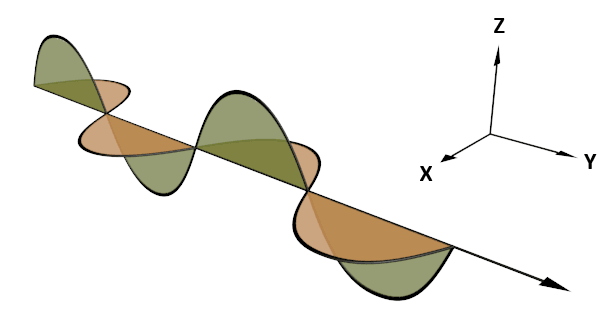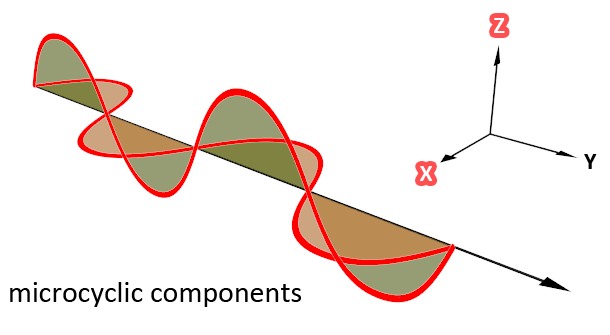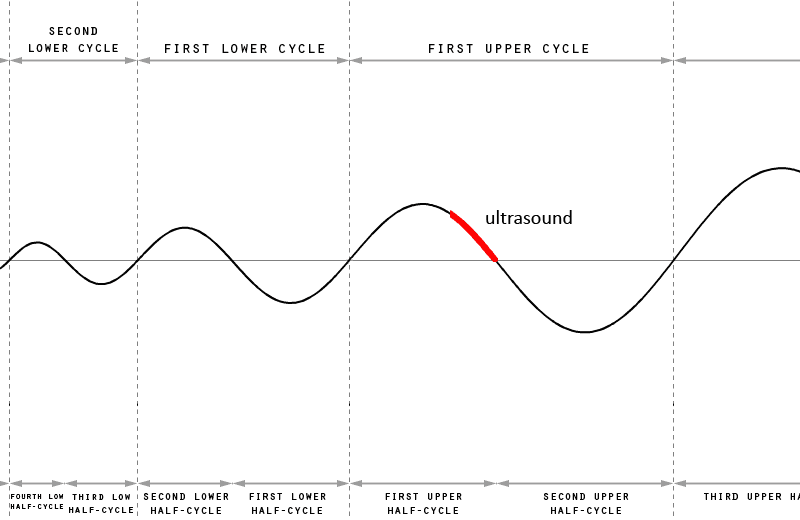Light
_UnderCC01.0.jpg)
Light is both a vortex and a wave. Or to say it more correctly: the vortex is the wave. It is a special case in the projection of waves from the onefield onto our three-dimensional world where the angle of projection is exactly zero and the entire wave is located within our physical world. This sets light apart from the other vortices in the sequence by its observed characteristics. Light is electromagnetic, yet it is visible. It can be blocked by physical objects, and it expands linear outward in all directions.
Light is a spiral, yet light does not look like a spiral at all. Light only shows straight lines of movement. Yet the vortex class of light is the class of the spirals, equipped with the characteristics of the spirals. The reason that light does not look like one of the spirals is because light is nearly zero dimensional, therefore there is so little freedom of movement within the vortex that there is no possibility of bending its path of movement to achieve an inward or outward rotation. At such low dimensionality level the movement can only be a straight line.
An introduction to light as a vortex was presented on the page about the movement near the EM spectrum. On this page we will discuss more properties of light in terms of vortex movement, along with how these characteristics fit within the infinity theory. Terms like scale level interaction, dimensionality and vortex embedment will be used to explain some of the characteristics of light.
Understanding Light
The vortex that we know to be light always has the same basic shape, and it always stretches out to infinity. This however does not mean that light does not have a size. Like other vortex types light does come in different sizes, and although it always stretches out to infinity, the size of the vortex does limit the range at which the light can illuminate other objects within the vicinity.
The light from the sun would not be able to illuminate the earth if that light consisted of billions of small light vortices generated from billions of small light bulbs. The light from the sun is able to illuminate the earth because it is generated by astronomically huge vortices (two zero-dimensional spirals), which have the same scale size as the photosphere that connects them.
| Macrocyclic Light | Mesocyclic Light | Microcyclic Light |
_UnderCC01.0.jpg) Image from Vormelker (Pixabay) |
_UnderCC01.0.jpg) Image from Yongwoon (Pixabay) |
 Image © Hans Hillewaert (Wikimedia), Under CC BY-SA 4.0 license |
A light-bulb generates mesocyclic light, which is light at the mesocyclic scale level. Such artificial light is mesocyclic light because of the size of the bulb, which spawns a light vortex embedded into the bulb vortex (this phenomenon is called vortex embedment, and is explained on the page titled 'more about vortices'). If the bulb would be astronomically huge, we would be able to produce macrocyclic light, which would be light closer identical to sunlight. It is important to be aware that there is no replacement for sunlight. The only light that anything on earth can be exposed to that has the same properties of sunlight is sunlight itself. All other light that we can be exposed to is either very faint light from distant stars and galaxies (which is not sufficient for photosynthesis of plant life or for the production of vitamin D by mammals) or mesocyclic light created here on earth. Although the microcyclic scale level is too small to be seen with the naked eye, light at this scale still can be seen if it is produced by the billions of small vortices. Even at the microcyclic scale level the light vortices still stretch out to infinity. Two examples of microcyclic light are bioluminescence and neon light. Both types of light can be seen from fairly great distances yet not from very far. And both these types of light only illuminate objects at a short range.
What kind of wave/vortex is light?
Light is said to be an electromagnetic wave that is produced by a vibrating electric charge and as such, it consist of both an electric and a magnetic component. The two oscillating components of light are an electric field and a magnetic field perpendicular to each other and to the direction of motion (a transverse wave). Yet this description does not account for all the forces we find in light.
Light is only electromagnetic but it does exert a pushing force on physical objects in the form of radiation pressure, although this force is very small and can not be detected in most circumstances. Spacecrafts for example do get pushed by the sun's radiation pressure to such an extent that over periods of time or long distances of travel the flight path needs to be adjusted because of the influence of this small force.
A pushing force on physical objects is also what we find in acoustic waves, which are a form of pressure waves. While the electric waves and magnetic waves are transverse waves, the pressure waves are longitudal waves. Pressure waves are exerted by vortices within the first half-cycle that are further away from the boundary. Audible sound for instance is exerted from the location of the central balance point. Infrasound is exerted from the lower dimensional vortices like the swirl and helicone. The lower dimensional the vortex is, the longer the wavelength, and the lower the frequency.
It is logical to suspect that even the lower dimensional vortices, like the disc, spire and also light, also exert these pressure waves, yet at even longer wavelengths, and even lower frequencies, lower frequencies than infrasound. Because the wavelength is so long the wave itself can not be detected.

The conclusion therefore should be that electricity and magnetism aren't the only two wave components of light. Light has a third wave component, pressure, which has a extremely small frequency and extremely long wavelength, which makes it undetectable, except only by small anomalies in the movement of some physical objects. These three components are oriented perpendicular to one another.
This means that light has two wavelengths, one that is equal for both the electric component and the magnetic component, and a second one that is a different, much longer wavelength then the one for the first two components. This second wavelength is undetactable because of the zero amplitude of the pressure component, therefore we have no ways of measuring that wavelength. But because the speed of light within the same vacuum is always equal no matter what the wavelength of the electromagnetic components is, it is assumable that this second wavelength is always equal to all forms of light. One could suggest that this wavelength is simply infinite, which would explain a speed of light that is always a constant number (c=299792458 m/s), but then one would expect the speed of light not just to be constant, but to be infinite as well, which is not the case. Also, the speed of light is different within different mediums (for instance, it is slower in glass), and can even deviate within different types of vacuums. The most likely scenario therefore is that the pressure component wavelength of light for a vacuum is a very large number.
Action and Reaction of Light
So there are three wave components of light, an electric component, a magnetic component, and a pressure component. Important to know is that these components do not occur on the same scale level. The electric and magnetic components have very small wavelengths and occur on the microcyclic scale level. The pressure component on the other hand occurs on the mesocyclic scale level. The pressure component has to be mesocyclic otherwise it would not be able to push objects that are mesocyclic in size. which is an observed characteristic of light. A microcyclic wave or vortex can not push or pull a mesocyclic object (such as a solar sail).

A fundamental characteristic between these three components is that all three components move perpendicular to one another. The reason that they move perpendicular is that the electric and magnetic component exist as a reaction to the force exhibited by the pressure component. An action on the mesocyclic scale level results in a reaction in the microcyclic scale level.
According to today's modern consensus, the electric and magnetic components of visible light have a wavelength of between 400 to 700 nanometers (nm), irrespectively of the type of visible light. If the light is generated by a very small light source, like and LED lamp, its wavelength lies between 400 and 700 nanometers. If the light is generated by a very large light source, even as large as the sun, then the wavelength of the light also lies between that same range. This is illogical if we consider how the interaction of scale levels is perceived in the infinity theory. It is against expectation that a vortex no matter what size always produces a counter-reaction on the microcyclic scale at always the same size (wavelength). Either the data that has been obtained from measurements that has lead to the consensus has been misinterpreted and there exists no fixed wavelength for visible light, or there is something incorrect about the infinity theory's notion on how scale interaction of vortices operates.
A Link Between Light and Sound
It might not have been obvious, but there is a clear link between light and sound. There is a clear link between the types of waves that define those two phenomena. Although they are different, both light and sound emerge from the same wave within the same continuity within transformation sequence, but with a different frequency and wavelength.

When the frequency of ultrasound is reduced (and wavelength increased), we get audible sound. When the frequency of audible sound is reduced (and wavelength again increased), we get infrasound. When the frequency of infrasound is reduced (and wavelength yet again increased), then this is where light emerges.
Please do not confuse the growing sinus curve of the transformation cycles (illustrated above) with the sinus curves for the wave frequency (illustrated below). Both sinus cuves have a completely different meaning.
The link between light and sound has not been so obvious because of the difference in characteristics. This difference is much greater than the difference between infrasound and audible sound and much greater than the difference between audible sound and ultrasound. One reason for the dissimilarity is the near zero amplitude of the pressure component of light, which makes its pressure component undetectable. The wave can not be measured by any means, but the fact that light can push objects somewhat similar as sound can push objects can be observed. A second reason for its dissimilarity is that light is located on the zero point within the transformation sequence, while any form of sound is not.
Polarized Light
A strong reason to believe that light is a spiral, and not any other class of vortex, is the existence of polarized light. Unpolarized light is composed of two types of light that oscillate with a different orientation. Each can be filtered out individually by an optical filter that allows only one of the two polarizations to pass. It is likely that each of these polarizations is the light from a different spiral, one left-turning (male), the other right-turning (female), and both connected by an outer bridge, or perhaps a tunnel.
The fact that we are looking at a static orientation of filters and not at a curved inward rotational left or right movement of a spiral is because the spiral itself is almost zero dimensional. There is hardly any freedom of movement at all, thus the shape of the vortex is much too simple to include a left or right curved movement, instead, only an orientation in how the wave-vortex propagates is what differentiates the left-turning spiral from the right-turning spiral.
Researchers have developed a way to produce twisted light beams using silicon chips, the starting point for compact. Xinlun Cai and colleagues shaped photons using a microscopic, ring-shaped grating, which sent twisted light out in a specified pattern. The different direction of twisting depends on the polarization of the original light.
If you click on the image below, it will open a page on another website. Take a moment to look at the contents of that page.

Image by Xinlun Cai / Jianwei Wang / Mark G. Thompson / Siyuan Yu
The spirals are highmorph disc spirals. Thus not light that is zero dimensional but more than half a dimension level higher than that. This tells us that light is a spiral, and can be both left and right turning, which is a needed requirement for creating an outer bridge and a binary spiral. And as we now understand, a needed ingredient for polarization of light.
If we study the sun, which emits unpolarized light, we find out that the brightest part of the sun is the photosphere, which is even brighter than the corona. But the photosphere does not have the shape of a light vortex, which should be nothing more than straight lines going in all directions from a single point. It is probable that this photosphere is what connects these two opposite spirals, and thus must be an outer bridge or a tunnel. There is some uncertainty here, because its a tricky puzzle, and there are several possibilities. But so far this seems to be the most logical answer.
Orbs are always spherical, mostly near perfect spheres. But they can belong to different classes. In this case, the photosphere appears to be a bridge or a tunnel. If light is indeed a spiral then it can be a single spiral or two spirals with a bridge or tunnel. Thus the difference between polarized and unpolarized light. The two spirals of light must be casting theirs rays of light from the same point into all directions, both spirals taking in the same space (but their rays probably don't touch).
Why do elliptical galaxies emit so much light?
Spirals can show a particular behavior in which the presence of one type of spiral, with the inclusion of a force of movement, can induce the creation of another smaller spiral, that is 6 dimension levels lower than the first spiral. This phenomenon called vortex embedment, and is discussed in detail in the page 'More about Vortices'.
For instance, a binary disc spiral connected with an enexus bridge can appear inside the cross-section of a revolute. The second vortex is 6 dimension levels higher than the first. A binary swirl can appear in the cross-section of a scroll. Again the second vortex is 6 dimension levels higher than the first. And unpolarized light, which is also a binary spiral, can appear within the volume of a binary bulb, and thus polarized light can appear within the volume of a single bulb. This is the reason why elliptical galaxies emit so much light, and why the light bulb has the shape of a bulb vortex. Again the second vortex is 6 dimension levels higher than the first.

The difference however is that the last example is a vortex located in a higher cycle. It is a bell vortex in the second cycle not a spiral in the first cycle. A light bulb's volume is a partial vacuum, thus the vessel, not the bulb. It could be that this means that the wake sheet behind an airplane is also a vortex within the second cycle, not the first cycle. Thus a binary tube ring, not a binary scroll ring. Or the same effect works for both the vortices in the second cycle as in the first cycle.
| All content on this site that is authored by Peter.A.Venis is licensed under the Creative Commons CC BY 4.0 license, unless otherwise mentioned. Most pages on this website also include material from other authors, under different licenses. Both the author's names and the licenses are mentioned in the file names whenever this information is known and can be provided. The presence of work from other authors on this website does not necessarily imply that those authors endorse the contents of this website. |
| A word that is often used on this website is the word 'vortex'. Many sources describe a vortex as a movement in a fluid that has a rotational flow. Yet many of the vortices that I describe on this website do not show a visible rotational flow. I took the liberty of using the word vortex for describing a phenomenon that had not been understood before, one that links together rotational and non-rotational movements. Even a movement in a straight line can in some cases be categorized as a vortex, if it is known that that movement is created by certain identical conditions. So keep in mind that the word 'vortex', within the context of the infinity-theory, has not the exact same meaning as other sources describe. |



